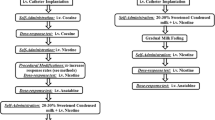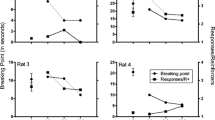Abstract
Tolerance to the suppressive effects of cocaine on milk drinking by rats was studied using a contingent tolerance experimental design. Three separate groups (n=6) of rats received 8.0, 16.0, or 32.0 mg/kg cocaine daily 15 min before a 15-min period of access to sweetened condensed milk for 20 days. Three additional groups of six rats each received the same chronic doses 15 min after access to milk. Milk, water, and food intake as well as body weight were measured daily. Tolerance effects were assessed by comparing initial acute dose-effect determinations with a probe dose-effect redetermination in which all rats again received doses of cocaine pre-session after having experienced the differential pre- or post-session chronic treatment. Behavioral tolerance on the milk intake measure was observed for the 8.0 mg/kg and 16.0 mg/kg doses, but not for the 32.0 mg/kg chronic treatment, even though the latter group exhibited evidence of tolerance in the water intake measure. Chronic treatment with 8.0 and 16.0 mg/kg produced different outcomes in that chronic exposure to 16.0 mg/kg in the presence of milk resulted in generalization of tolerance to both a lower (8.0 mg/kg) and a higher dose (32.0 mg/kg), but the group receiving 8.0 mg/kg did not exhibit generalization of tolerance to higher doses. Modest sensitization effects were observed in the rats treated post-session with either 8.0 or 16.0 mg/kg. Rats receiving 32.0 mg/kg pre-milk exhibited a dramatic lowering of food intake and concomitant loss in body weight compared to the same dose given after the milk access period, suggesting that pairing cocaine with a highly palatable substance may enhance its toxic effects. The observed behavioral tolerance effects were discussed in terms of (1) the reinforcement loss hypothesis, (2) the channeling hypothesis developed in the context of behavioral tolerance to amphetamine, and (3) the concept of dose-specific tolerance.
Similar content being viewed by others
References
Chen CS (1968) A study of the alcohol-tolerance effect and an introduction of a new behavioral technique. Psychopharmacologia 12:433–440
Demellweek C, Goudie AJ (1983) An analysis of behavioral mechanisms involved in the acquisition of amphetamine anorectic tolerance. Psychopharmacology 80:287–303
Foltin RW, Schuster CR (1982) Behavioral tolerance and cross-tolerance to dl-cathinone andd-amphetamine in rats. J Pharmacol Exp Ther 222:126–131
Heffner TG, Hartman JA, Seiden LS (1980) Feeding increases dopamine metabolism in the rat brain. Science 208:1168–1170
Imperato A, Mele A, Scrocco MG, Puglisi-Allegra S (1992) Chronic cocaine alters limbic extracellular dopamine: neurochemical basis for addiction. Eur J Pharmacol 212:299–300
Johanson CE, Fischman MW (1989) The pharmacology of cocaine related to its abuse. Pharmacol Rev 41:3–52
MacPhail RC, Seiden LS (1976) Effects of intermittent and repeated administration ofd-amphetamine on restricted water intake in rats. J Pharmacol Exp Ther 197:303–310
McMillan DE, Leander JD (1976) Effects of drugs on schedule-controlled behavior. In: Glick SD, Goldfarb J (eds) Behavioral pharmacology, Mosby, St Louis, MO, pp 45–139
Nayak PK, Misra AL, Mule SJ (1976) Physiological disposition and biotransformation of (3H) cocaine in acutely and chronically treated rats. J Pharmacol Exp Ther 196:556–569
Pearl RG, Seiden LS (1976) The existence of tolerance to and cross-tolerance betweend-amphetamine and methylphenidate for their effects on milk consumption and on differential-reinforcement-of-low-rate performance in the rat. J Pharmacol Exp Ther 198:635–647
Reith MEA (1988) Cocaine receptors on momoamine transporters and sodium channels. NIDA Res Monogr 88:23–43
Rowland NE, Antelman SM, Kocan D (1981) Elevated water intake in rats treated chronically with amphetamine: drinking in excess of need? Appetite 2:51–66
Salisbury JJ, Wolgin DL (1985) Role of anorexia and behavioral activation in amphetamine-induced suppression of feeding: implications for understanding tolerance. Behav Neurosci 99:1153–1161
Schuster CR, Dockens WS, Woods JH (1966) Behavioral variables affecting the development of amphetamine tolerance. Psychopharmacologia 9:170–182
Smith GP, Schnieder LH (1988) Relationship between mesolimbic dopamine function and eating behavior. In: Kalivas PW, Nemeroff CB (eds) The mesocorticolimbic dopamine system, Ann NY Acad Sci 537:254–261
Tizzano J, Bannon A, Liberto R, Anderson J, Roberts D, Muchow D, Kallman MJ (1986) Behavioral tolerance to diazepam as a consequence of the dose administered chronically. Soc Neurosci Abstr 12:923
Winn P, Williams SF, Herberg LJ (1982) Feeding stimulated by very low doses ofd-amphetamine administered systemically or by microinjection into the striatum. Psychopharmacology 78:336–341
Wolgin DL (1973) An analysis of the anorexigenic effects of amphetamine. Unpublished doctoral dissertation. Rutgers University, New Brunswick, NJ
Wolgin DL, Thompson GB, Oslan IA (1987) Tolerance to amphetamine: contingent suppression of stereotypy mediates recovery of feeding. Behav Neurosci 101:264–271
Wolgin DL, Kinney GG (1992) Effect of prior sensitization of stereotypy on the development of tolerance to amphetamine-induced hypophagia. J Pharmacol Exp Ther 262:1232–1241
Wolgin DL (1989) The role of instrumental learning in behavioral tolerance to drugs. In: Goudie AJ, Emmett-Oglesby MW (eds) Psychoactive drugs: tolerance and sensitization, Humana, Clifton, NJ, pp 17–114
Woolverton WL, Kandel D, Schuster CR (1978) Tolerance and cross-tolerance to cocaine andd-amphetamine. J Pharmacol Exp Ther 205:525–535.
Author information
Authors and Affiliations
Additional information
Supported by DA 05/253
Rights and permissions
About this article
Cite this article
Bowen, S.E., Fowler, S.C. & Kallman, M.J. Effects of variation in chronic dose of cocaine on contingent tolerance as assessed in a milk-drinking task. Psychopharmacology 113, 67–75 (1993). https://doi.org/10.1007/BF02244336
Received:
Revised:
Issue Date:
DOI: https://doi.org/10.1007/BF02244336




